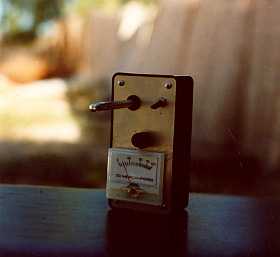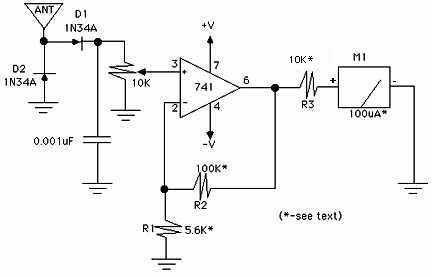
FIELD STRENGTH METER
Cost estimate: $12
If you have a ham radio license and a transmitter, it really helps to check if your signal is coming out of the antenna! This extremely sensitive field strength meter will show whether or not something is being transmitted and indicates any changes in power output or antenna design. It does NOT indicate whether the signal is free of spurious (unwanted and illegal) emissions - for that a tunable field strength meter (wavemeter) is needed. Nonetheless I find that this unit comes in very handy for checking a transmitting system.
A big advantage is the wide range of meters that can be used for this project; almost anything that can be found will work. I threw this design together myself with what I had on-hand at the time and use it frequently.
How it works: RF signals entering through the antenna are detected by voltage-doubler diodes D1/D2. A 741 IC op-amp configured as a non-inverting amplifier increases the signal by a factor determined by R1 and R2 according to the formula
GAIN = 1 + ( R2 / R1 )
and finally a micro- or milli- ammmeter, shunted by resistor R3 to read 1-volt full-scale, displays the amplified signal strength.


Construction: Build on a prototyping board first and start with R1 and R2 values shown, with appropriate R3 value for the meter you have (see M1 in parts list below). Apply power. The circuit will probably need adjusting to zero the meter: add resistance in increments of about 10% of R3 in series with M1 to bring the meter needle to zero - this will take some trial-and-error. Alternatively, a zero-adjust potentiometer can be inserted between M1 and ground. For more gain, increase the ratio of R2 to R1 and re-zero the meter. Use a walkie-talkie, remote or cellular phone, toy car remote control - anything that emits an RF signal - to confirm that it's working. Solder and assemble the unit. An IC socket for the 741 is always a good idea.
Operation: Extend antenna, power up, and approach RF source. Adjust sensitivity control (10K pot) for desired reading. My version, built with the values given in the schematic, pins the needle when brought to within 6 feet of my dipole antenna fed with the Mighty Mite transmitter powered at 14 volts.
PARTS LIST
R1 - 5.6K-ohm resistor (see text)
R2 - 100K-ohm resistor (see text)
R3 - resistor appropriate for meter used (see M1 description below)
M1 - any meter from 100uA to 100mA fullscale. Use Ohm's Law
to determine the R3 shunt resistor's value for meter chosen.
for: 100uA meter use: 10K resistor
200uA 5K
500uA 2K
1mA 1K
5mA 200-ohm
10mA 100-ohm
25mA 40-ohm
50mA 20-ohm
100mA 10-ohm
(Ohm's Law: R=E/I; in this application:
Resistance_in_ohms = volts_desired_fullscale / meter_current_in_amps_fullscale)
(If you have a 50uA (or less) meter, SAVE IT for a different project!)
(1) 10K-ohm potentiometer
(1) 741 op-amp integrated circuit
(1) 8-pin IC socket for above
(2) 1N34A germanium diodes, or equivalent.
(1) 0.001-uF ceramic disc capacitor
B1,B2 - 9-volt transistor-radio batteries
S1 - Double-Pole, Single-Throw Switch (or use 1/2 of DPDT switch...)
Collapsible portable-radio replacement antenna
(or use about an 18" of wire as an antenna), box, knob, etc.
..need parts?...
***HOME***
***RECEIVER***
***Q-MULTIPLIER***
***2-BAND VFO***
***500mW TRANSMITTER***
***3W 2-BAND TRANSMITTER***
***15 METER CONVERTER***
***15 METER VXO-TUNED TRANSMITTER***
***WATTMETER***
***CRYSTAL TESTER***
***SUPPLIERS***
comments?
email: jandg@brink.com



